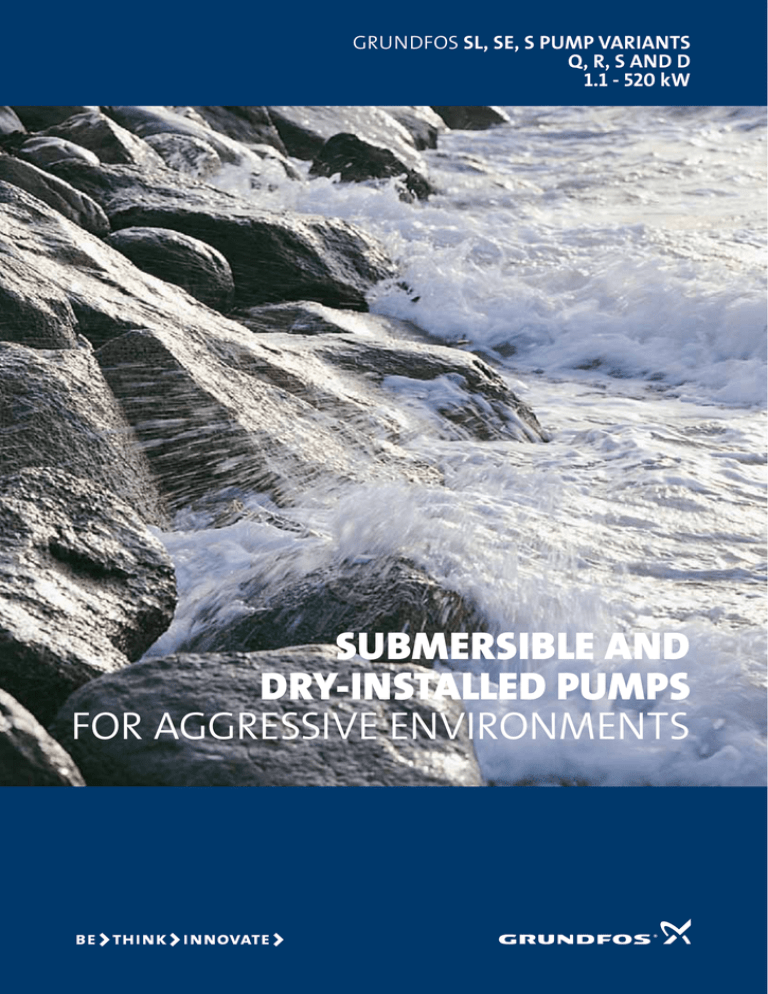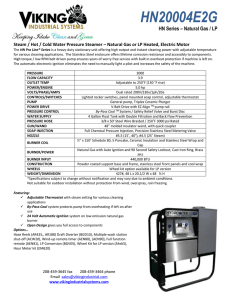
GRUNDFOS SL, SE, S pump variants
Q, R, S and D
1.1 - 520 kW
Submersible and
dry-installed pumps
for aggressive environments
The right pumps for
the right media
The extremely reliable and durable Grundfos SL, SE and S wastewater pumps are made partly or entirely of high-grade stainless
steel. These powerful pumps are built for handling wastewater,
process water, seawater and unscreened raw sewage in aggressive environments that expose the pump to corrosive or abrasive
liquids and fluctuating pH levels.
Less downtime when pumping
in aggressive environments
Water intake – seawater, brackish
water, surface water
Recognised Grundfos quality means you get
• Correct choice of material for your application
• Trouble-free operation in aggressive media
• Reliable operation with less downtime.
In addition to a durable pump, you gain reliability and trouble-free, continuous
operation. The stainless steel construction is tailored to allow the pumps to work in
environments typical to the application in question, giving optimal protection
against corrosion, erosion, or a combined effect.
Grundfos can help you match pump materials to the media to be
pumped. The combination of stainless steel build quality and our
proven abilities with hydraulics ensures reliable operation without
pump failure because of corrosion, erosion, or a combined effect.
The pump hydraulics can handle solids and fibres effectively to resist
clogging. The impeller clearance is adjustable with SmartTrim, or
exchangeable wear rings which maintain a high efficiency over time.
Reliable pumps for submerged
or dry installation
Industrial wastewater with fluctuating pH and aggressive media
Typical applications for variant SL, SE and S pumps ranges cover aggressive environments
where the pump is at risk from corrosion, erosion, or a combined effect.
Water intake and seawater, brackish water, surface water applications
• Surface water intake
• Desalination plants
• Cooling of power plants and industries
• Process water for fish farming
• Marine and off-shore sector.
Pumping near coastal areas
Industrial wastewater
• Wastewater with fluctuating pH values, chemical constituents, temperature, and abrasive particles from, for example, the textile and chemical industry
• Process water from CIP and SIP cleaning processes in, for example, the pharmaceutical or food and beverage industries.
Pumping near coastal areas
• Seawater infiltration into wastewater systems, resulting in increased chloride levels
• Dewatering of farming areas near coastal zones resulting in salt water infiltration.
Wastewater
• Wastewater environments with high levels of hydrogen sulphide
• Highly oxygenated wastewater and effluents
• Wastewater dosed with aggressive chemicals
• Wastewater with a high content of abrasive particles, such as sand and grit
• Sludge, drain and percolate water containing aggressive elements.
Wastewater
Select from four basic variants
(1.1 kW – 520 kW)
In addition to cast iron, you can choose between the following four
variants of the S, SL, and SE pumps in stainless steel.
Variant Q
Stainless steel impeller in EN 1.4408.
Volute is cast iron and motor
housing either cast iron (SL, S) or
with a stainless steel motor jacket (SE).
SL pump
SE pump
Typical applications
Why corrosion and erosion is an issue
The Grundfos ranges of stainless steel SL, SE and
S wastewater pumps with large free
passage ensure that you always have the
correct pump built with the right materials
for the application. All pumps can be
further customised, depending on your
requirements and the media to be pumped.
There are a number of environmental variables that affect
the corrosion resistance of metals and alloys, not least that
all types of materials and coatings inevitably deteriorate at a
given rate of corrosion or erosion. Furthermore, in a corrosive
environment, erosion can further accelerate corrosion of the
pump. This deterioration must be considered and calculated
into the expected lifetime for the pump.
The causes of corrosion
Corrosion is the deterioration of a metal caused by a reaction
with its environment. Corrosion of a pump involves the loss of
metal and occurs in various forms ranging from a generalised
attack over the entire surface to a severe concentrated attack,
which eventually can cause the pump to fail.
S pump
Variant S
Stainless steel hydraulic parts are in
EN 1.4408 with the shaft upgraded to
EN 1.4462. Motor housing is either cast iron
(S) or with a stainless steel motor jacket (SE).
One of two SE pumps for pumping wastewater
containing chemicals with large variations in pH
from the CIP process at a dairy producing cheese.
A variety of different media and the specific environment can
induce corrosion of a pump. These include:
• pH
• Oxidising agents (such as oxygen)
• Temperature
• Concentration of solution constituents (such as chlorides)
• Biological activity
• Operating conditions (such as velocity, cleaning procedures and shutdowns)
• Chemicals.
In situations where metallic parts are exposed to these
environmental variables, stainless steel is considered more
corrosion-resistant than cast iron. This is due to the fact that
stainless steel contains a defined minimum content of chromium, and this chromium content promotes the formation
of passive, invisible oxide film on the surface that prevents
surface corrosion and protects the metal beneath.
How erosion happens
Erosion by particle impingement can be damaging to pump
parts by itself and it can furthermore accelerate corrosion in
aggressive environments. Erosion is a localised process that
constantly removes material from the pump parts.
Erosion occurs primarily in areas with high velocity and turbulent flow, and it is thus typically seen on impellers and volutes.
Stainless steel has an erosion-resistant oxide film on the
surface, which makes it more resistant towards media with a
high content of abrasive particles, compared to standard cast
iron pump parts.
The right material for optimum resistance
SE pump
The following graphs are intended as a general guide for
selecting the suitable pump materials for your specific application, evaluated according to pH value, chloride concentration
and wear. The suitable pump variant should be selected from a
cross-reading between several of the graphs.
S pump
Variant R
All parts in contact with media are entirely of
stainless steel EN 1.4408 with the shaft
upgraded to EN 1.4462.
For final specification and selection of your pump, exact media
data and variations should be obtained. Grundfos can give you
further support to match pump materials to the media to be
pumped.
pH
The pH value is a good indicator for corrosive behaviour,
however pH is insufficient
on it’s own to evaluate a
media as its composition
and variations must be
considered before final pump
configuration.
Dsub+dry
Sdry +Rsub+dry
One of two S pumps used at a glass wool
manufacturing plant for pumping process water
with a high content of abrasive particles.
SE pump
S pump
Variant D
All parts in contact with media are entirely of stainless steel with the critical parts upgraded to EN 1.4517
for casted parts and EN 1.4539 for plate material.
DIN/EN
AISI/ASTM
1.4408
AISI 316/A351 CF8M
1.4462
UNS S32205
1.4517
ASTM A890 1B
1.4539
AISI 904L
Material declaration:
Grey cast iron are manufactured according to EN 1561:1997
Cast stainless steel are manufactured according to EN 10283:2010.
Conversion to other standards as AISI/ASTM are normative and products
are not manufactured according to these.
SE pump
S pump
Coating*
Ssub
Coating*
Qsub+dry
Coating*
Standardsub+dry
Acidic
Neutral
Alkaline
pH-value
0 1 2 3 4 5 6 7 8 9 10 11 1213 14
sub=submerged installation
dry=dry installation
* Depends on specification of the coating
40
Temperature [⁰C]
Aluminium anodes
Dsub+dry
35
Sdry and Rsub+dry
30
Qsub+dry and Ssub
25
20
Stainless steel pumps used for brackish
and seawater
To minimise the risk of corrosion, the
pump must be running continuously,
meaning that standstills must not exceed
six to eight hours. Resistance in these
aggressive environments may be limited.
Contact Grundfos for an evaluation of
your conditions.
Standardsub+dry
Sacrificial aluminium anodes can be
used for corrosion protection of both cast
iron and stainless steel parts. Aluminium
anodes perform optimally in seawater, but
some protection will also be achieved in
brackish water. Aluminiumanodes have no
effect in acidic or alkaline environments.
15
10
5
0
40
Fresh
10
Brakish
100
Upgrade standard pumps for
aggressive environments
Cables in different materials or
with protective hose
Chain in stainless steel
O-rings available in
different materials
Seawater Brine
Chloride [mg/l]
1000 10000100000
Temperature [⁰C]
sub=submerged installation
dry=dry installation
* Depends on specification of the coating
Auto-couplings and
base stands in stainless steel
Shaft seals for different media
Aluminium anodes
+ coating*
35
30
Aluminium anodes
Coating*
25
20
No add-ons
15
In environments where stainless steel is at risk from corrosion,
erosion or a combined effect of the two, coating the standard
pump casing, volute and impeller can be a good alternative.
Brackish or seawater environments that contain high chloride
levels are typical examples of applications where pumps may
be at risk. Coatings of pump parts can be tailored to fit to
specific applications and customer requests.
10
5
0
Fresh
10
Brakish
100
Seawater Brine
Chloride [mg/l]
1000 10000100000
Wear resistance
Coated* pumpssub+dry
Dsub+dry
Ssub
Sdry and Rsub+dry
Qsub+dry
Erosion resistance
Erosive wear is determined by many
parameters, such as the geometry, size,
sharpness, composition and content of
the abrasive particles. This means the
pump materials may in some applications
behave differently from what is shown
in the graph. If combined with a corrosive liquid, erosion rates can be further
accelerated.
Important information about these graphs
Grundfos provides these graphs as a service, as a guide
for preliminary pump specifications and pre-selection.
The information shown in the graphs is based on experience and available literature, which we have reported as
accurately as possible.
Standardsub+dry
Corrosion resistance
Deviations due to specific media composition may
impose erroneous results from the graphs for which
Grundfos disclaims any and all liability.
Reducing the risk of corrosion
Where erosion is a minor issue for the external parts of the
pump, a coating that offers protection against corrosion for
surfaces immersed in saline liquids and aggressive chemicals
may be sufficient.
Reducing the risk of erosion corrosion
Where erosion corrosion with abrasive and/or saline liquids
puts the impeller and volute casing at risk, a ceramic-filled
coating offers superb resistance to erosion and outstanding
resistance to a broad range of chemicals.
Even with a flawless coating, cracks and perforation resulting
from operational wear will expose the underlying material
to the aggressive media, with corrosion as an effect. This
means that coatings should be inspected regularly to
ensure sufficient protection and product lifetime.
Aluminium anodes for high chloride levels
Sacrificial aluminium anodes can be used for corrosion
protection of both cast iron and stainless steel parts,
where the anodes will be corroded, instead of the pump
parts. Therefore aluminium anodes should be inspected
regularly to maintain protection. To increase lifetime of
the sacrificial aluminium anodes, it is recommended
that cast iron or stainless steel components are
painted or coated.
In some cases a coating used together with
sacrificial aluminium anodes may offer
sufficient protection to a cast iron
pump in chloride-containing water.
Grundfos Holding A/S
Poul Due Jensens Vej 7
DK-8850 Bjerringbro
Tel: +45 87 50 14 00
www.grundfos.com
The name Grundfos, the Grundfos logo, and the payoff Be–Think–Innovate are registered trademarks
owned by Grundfos Holding A/S or Grundfos A/S, Denmark. All rights reserved worldwide.
97 74 57 65/0412/WATER UTILITY/9771-D&I
Being responsible is our foundation
Thinking ahead makes it possible
Innovation is the essence




